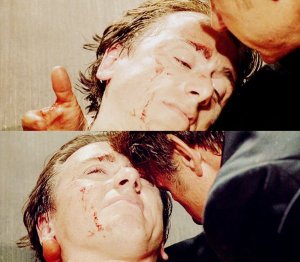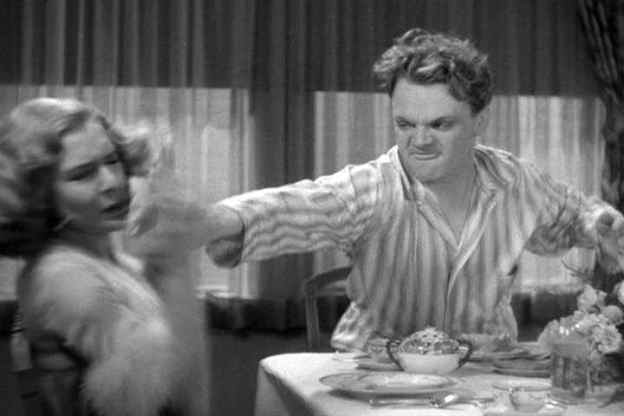Our Year 12 students recently watched Reservoir Dogs, and in order to put that in a context for them, I’ve been thinking about the crime and heist genres. I’ll be posting about a few of these films over the next few days and, hopefully, encouraging some students to see some new films. (Or old ones.)
Whenever I teach about the crime movie, or even think about it, I go back to the early Hollywood gangster pics. Under the studio system, Warner Brothers was considered the ‘gangster’ studio, and one of the best they made, of course, was William Wellman’s 1931 classic The Public Enemy. Starring James Cagney, this is the film that really broke him as a star and just as Cagney is perhaps the prototypical star of gangster film, The Public Enemy is one of the films which absolutely defined the genre.
Reflection theory tells us that films or other texts tend to be influenced by what is going on in the world at the time of making. What was happening in America in 1931? Prohibition, for a start. Alcohol would still be illegal until 1933, and the film, like many others made at the time, uses the illegal booze industry as the background or all the criminality in the film. The Great Depression was reaching its worst point, and audiences, it has been suggested, can more easily identify with, or at least be interested in, a man who turns to crime when times in the real world are tougher. So, in every way, The Public Enemy is informed by its time; but, it’s still very watchable now because the themes it encodes, about loyalty and family and brotherhood and morality, remain entirely relevant today. That’s why today’s crime films convey exactly the same ideas.
The plot is pretty standard fare for then or now. A young man, alienated from his own family, seeks to belong somewhere else and finds a surrogate family in the local Mob. (So that’s where Goodfellas got that idea from.) He starts small but his crimes escalate and we see him reap the rewards – flashy cars and restaurants and beautiful woman (one of whom famously gets a grapefruit in the face.) Obviously, there’s a turning point – and, in the 50s reissue of the film, a tacked-on moral point which is not actually as clear as the producers of the film might later have pretended.
How does it influence current films? In many ways. Using Reservoir Dogs as an example, we can see a range of influences:
- It’s a gendered text. This is a male film, about masculinity. As is common with American fiction of all sort, relationships between men are shown to be closer than those between men and women. The women are peripheral to the men’s lives; the real loyalty and love in this story is between Matt Doyle and Tom Powers. These two men grow up together, share their work and play and, effectively, their lives. The exception, by the way, is the mother; Tom loves his mum and the mother – son relationship is represented as wholly positive and good. Reservoir Dogs is the same – there is not a single woman in the film. (This does not, however, necessarily mean it is sexist. More later.)
- It’s about family. We see young Tom, already predisposed to crime, beaten by his father and hectored by his older brother. Later, he is beaten by that same brother. He is defiant and dismissive, but vulnerable – we see later how he wants his mother’s love and his brother’s forgiveness As such, he seeks acceptance somewhere and he finds it in the criminal gangs of a series of older men. We see the same in Reservoir Dogs in the figures of Mr Orange and Mr White. While Mr Orange is dying, Mr White cradles him, holding and speaking to him like a baby. Although there is double-crossing going on, the relationship between these two is close and genuine – a father and his son.

- We identify with the criminals. Generically, the difference between the crime drama and the police drama, or police procedural, is which side of the crime the audience is located on. Here, we follow the criminals, not the cops. And as a result, we are more likely to sympathise with the criminals. That’s certainly the case here; although Cagney’s Tom Powers is in every way reprehensible, we have Cagney’s star appeal beaming out of him and making him irresistible. Likewise in Reservoir Dogs, we can’t help but warm to characters like Steve Buscemi’s Mr Pink – even though he’s a self-centered, murderous thug who doesn’t tip. More than that, we buy into the criminal code; within the diegeses and ideologies of these films, the worst crime against masculine honour is to betray your mob ’brothers’ – we see it in both films, and we see how keenly the betrayal is felt and (possibly, in Reservoir Dogs but most definitely in The Public Enemy) how savagely it is punished.
- Attitudes to women are shown to be questionable, to say the least. Although I’ve already said that these texts are gendered, there are often strong women in the films. Jean Harlow’s Gwen is one such in The Public Enemy – a woman who appears to be a match for Cagney’s Tom. But we see, in the ‘grapefruit’ scene and elsewhere, how Tom is incapable of sustaining relationships with women apart from his mother (and he struggles there at times too.) He is a man’s man in every way. It has been said that there is a strong streak of homoeroticism in American literature and film – think of Tom Sawyer and Huck Finn, Captain Ahab and Ishmael, Starsky and Hutch, Batman and Robin; a great deal of American narrative is based around the bromance, the male partnership or relationship. Reservoir Dogs, as noted, goes far beyond this in that there aren’t actually any women in the film to be in twisted relationships with – but when the men talk about women, as in the conversation about Madonna at the start, or Elois (the woman who glues her partner’s penis to his stomach), it’s easy to argue that Tarantino is seeding these men with a warped sense of where women fit in their worlds. It has been argued that there’s actually a sophisticated feminism at work in this characterisation.
There are lots and lots of other similarities – the iconography and locations, the wise-guy dialogue, the violence– but this post is already long enough. Just watch it! You’ll see Jimmy Cagney get a tooth punched out (really), nearly get shot in the head (really) and Mae Clarke, obviously, get a grapefruit in the face. (Really.)

